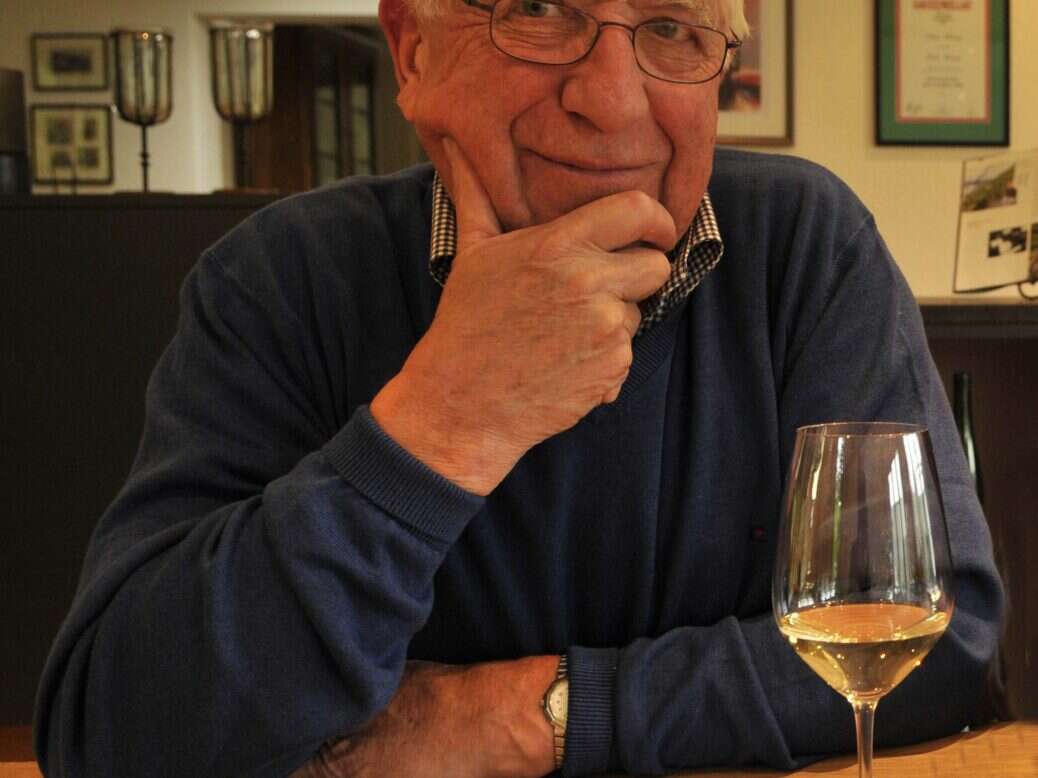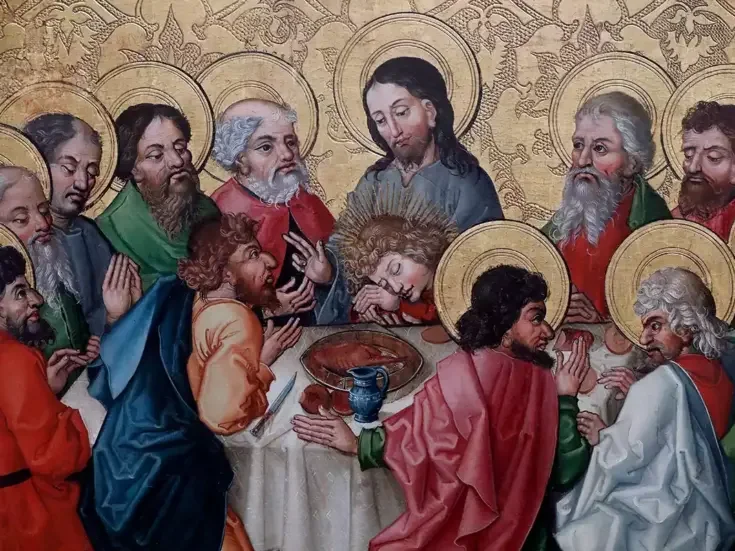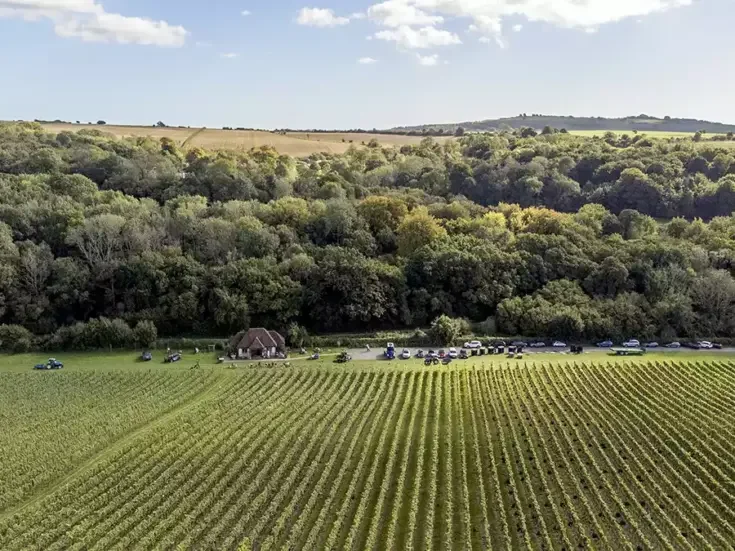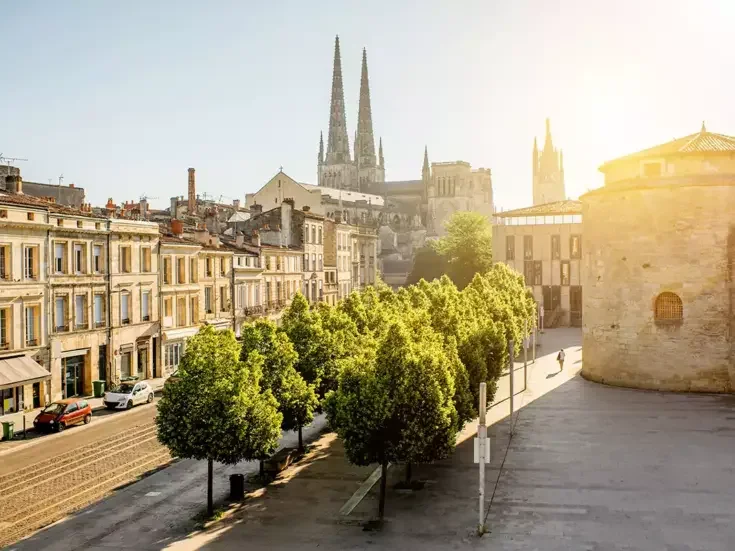
A visionary winemaker whose work at the family estate and beyond helped reshape the image of fine German wine
A tribute to Wilhelm Haag, who left us late last December, is bound to begin—as did one’s personal acquaintance—with his vice grip of a handshake. Even those who had been warned—and that trademark greeting, like its instigator, acquired legendary status within Haag’s lifetime—were sure to be taken aback. Time seemed to confirm Einstein’s predictions under the force of that huge, powerful right hand, worn hard by viticultural labor punctuated by the almost equally strenuous recreational pursuit of rowing. (Haag met the love of his life, Ilse, at a regatta). Withdrawal or resistance was futile. There was nothing to do but squeeze back with all of one’s might. How to interpret this signature gesture: as greeting or intimidation, some sort of challenge or a glimpse into the personality you were about to experience? Soon enough you knew the answer: “Yes” on all counts.
Recapturing mystique
For at least ten generations, Haags had farmed slopes along a tiny brook 2.5 miles (4km) upstream from its confluence with the Mosel. Almost exactly three centuries after the 1605 record of Haags first farming in tiny Burgen, Wilhelm Haag’s great grandfather married an heiress to the estate of Peter Christian Conrad-Fehres, then chief proprietor and promoter of vineyards on the Brauneberg. Wines from that massive slate hillside on the Mosel’s Left Bank were reported already in Thomas Jefferson’s 1788 travel diaries to be of “the 1st. quality (without any comparison)” among Mosels, a status confirmed by the tax classification of Greater Moselle vineyards undertaken under Napoleon in 1804. Brauneberg Riesling was likely the first Mosel to attract attention abroad. In 1833, English authority Cyrus Redding testified that “Brauneberg [has] within the last seven years become a fashionable beverage at the first tables in London,” while adding that “although it is become so fashionable, it is a cheap wine.” Conrad-Fehres succeeded in dramatically changing that. By 1876, a decade into Mosel Riesling’s half-century heyday, the Deutsche Weinzeitung was characterizing his estate as “renowned,” and auction prices for ten fuders of his 1874s as having “exceeded even the most audacious expectations.” Not long after the estate passed to Friedrich Wilhelm Haag, it became a founding member of the Grosser Ring consortium, today’s VDP.Mosel.
His family having moved 2.5 miles to Dusemond (while retaining its vineyards in Burgen), Friedrich Wilhelm’s son Ferdinand shed mixed agriculture for wine specialization under the estate name “Conrad-Fehres Erben (F. Haag),” eventually scoring successes at auction that echoed those of his illustrious maternal grandfather. But viticulture on the Mosel, as in so many places, slipped into serious decline after World War I, and the rechristening of Dusemond as “Brauneberg” in 1925, while a stroke of promotional genius, was rowing against a strong socio-economic current. Wilhelm Haag was born a dozen years later, in a vintage of fabled quality amid the darkest period in Germany’s history. His apprenticeship in wine had scarcely commenced when, in 1957, his father Fritz fell ill and Wilhelm was called home to manage the harvest. Young Haag eagerly gathered shriveled berries to produce a 1957 Beerenauslese. Fritz Haag, deeming that presumptuous, issued a harsh reprimand, and wouldn’t allow the grapes in question to be pressed. For the next 47 harvests, though, it was Wilhelm Haag calling the shots; and already in 1959 he bottled a Trockenbeerenauslese whose auction price grabbed headlines.
Those with the luck to have tasted (perhaps blind, under his scrutiny) Wilhelm Haag’s Auslesen from such subsequent vintages as 1969, 1971, 1975, or 1976 will be surprised that the wine literature of this period—including the well-known guides of Ambrosi, Loeb, Hallgarten, and Schoonmaker—at most merely cites the Fritz Haag estate as among numerous with Brauneberg holdings. As both parties tell it, pioneering American importer Kermit Lynch and Wilhelm Haag’s future import partner Rudi Wiest bonded over a mutual admiration for Thomas Jefferson that led them to ask each other: “Whatever became of once-renowned Brauneberg?” Both claimed never to have drunk a memorable example. One day, Lynch rang Wiest in excitement over a bottle of Fritz Haag 1971 Auslese acquired at the Trier auction. Enthralled by its flavors, Wiest persuaded importer Chris Hildebrandt to land a container full of Haag 1975s and 1976s in California, which Wiest promptly sold. Inspired by that experience, in 1982 Wiest founded an import company initially specializing in Mosel Riesling. Wilhelm Haag, though under contract with Hildebrandt for two more years, foresightedly agreed to be Wiest’s partner in a venture they named “ILNA,” a mash-up of the first names of their wives, who tackled the logistics and the mountain of ensuing paperwork.
While punctuated with vintages that captured international attention, the 1970s had been a hard decade for Mosel winegrowers. There weren’t even auctions in 1975, 1979, or 1981, owing to the dearth of unchaptalized Riesling from the immediately preceding vintages. A temptation to market wines under Prädikat designations to which they weren’t legally entitled—coupled with too few inspectors or laboratories to certify quality—led to widespread fraud. In 1984, Karthäuserhof proprietor Werner Tyrell was indicted for wine adulteration and forced to resign as President of the Grosser Ring. His successor was only the fourth person to hold that title, the first from the Mosel proper (rather than Saar or Ruwer) and the first hands-on grower and vintner (rather than just estate proprietor): Wilhelm Haag. That the right man for the moment had been chosen proved an understatement. The very next year, Germany reverberated with ugly repercussions from Austria’s glycol scandal. Haag set an example of quality, trust, and integrity, but also success. In September, 1985, with Mosel producers shunned by suspicious consumers and reeling from plummeting demand, Haag told Germany’s eminent weekly Die Zeit that he “would nearly have gone bankrupt” had he pandered to a desire for sugary, cheap wine; instead, demand from wholesalers was up 70 percent and “my specialty bottlings are completely sold out.”
Wearing multiple hats now—as winegrower, VDP-Mosel President, and import liaison—and with two young sons, Haag threw himself into the task of reviving his region’s as well as his signature site’s reputation. In 1986, he brought his Mosel-Saar-Ruwer colleagues to London for the first of what would become annual shows. He took the initiative in enlisting fellow VDP members—many of these (perhaps not by chance) hands-on wine growers like himself—to steal time from their estates and engage in tireless treks across Europe, North America, and the Far East explaining and advocating German Riesling—journeys that loom large in the memories of his fellow travelers. When in 1993 Robert Parker expressed an interest in reviewing wines from the ILNA portfolio, Haag wisely overrode Wiest’s objections and successfully took the gambit. Even as Trier auctions once again started achieving eye-watering hammer prices, Haag and Wiest were pursuing an approach designed to simplify German labeling and utilize high-quality, highly-affordable, dry-tasting generic bottlings as estate calling cards. There was—and remains—no finer such Gutsriesling than that of Weingut Fritz Haag, then as now based substantially on the family’s Burgen vineyards. This approach only enhanced the perception of Brauneberg Riesling as a pearl of great price. The name “Haag” appears nowhere in the 1987 edition of Hugh Johnson’s Modern Encyclopedia of Wine. A decade and two editions later one read: “A century ago, Braunebergers were the most sought after of all Mosel Rieslings. Virtually single-handed Wilhelm Haag has rebuilt that reputation.”
Diplomacy and directness
Haag brought to the task of Mosel revival the same tools he had cultivated as a grower and vintner, prominent among these patience, grit, and tenacity. He loved to explain how getting the right balance in Mosel Riesling routinely required “overcoming one’s inner Schweinehund” and tolerating long nights in the cellar monitoring fermentation and determining when to arrest it. “You have to take risks,” he would often say, which needn’t have applied only to harvest or vinification, “and you can never let yourself become jaded”—though one wonders whether he was ever personally at any risk of that. Haag’s talents also extended to comradely comportment, charm, and humor. Trying to simplify nomenclature and make wine law safe for Mosel Riesling “was an eternal war at the federal level, with few allies from other regions,” recalls Saar proprietor and long-time Trier auctioneer Eberhard von Kunow, who would succeed Wilhelm Haag as Grosser Ring President. “So, sometimes before federal hearings, Wilhelm would convene a little wine-drinking session with like-minded friends from other regions, concerned lest our arguments be misunderstood.”
Nahe winegrower and self-described “fellow vineyard venerator” Helmut Dönnhoff laughs when he recalls sharing a train ride with Haag to Berlin, where they had been invited as dinner guests of German Chancellor Gerhard Schröder. “We had had enough to drink,” relates Dönnhoff, “because, you know, a true Moselaner has to pack Riesling for a train ride. So, naturally, we began rehearsing our many objections to German politics as it affected wine. ‘When I get the Chancellor’s ear,’ said Wilhelm, ‘I’m going to tell him straight out that things can’t go on the way they have been.’” He had his chance the next day. “It was customary for such private audiences to last half an hour,” explains Dönnhoff. “So, on the ride home I was dying to know: ‘How long did you get?’ ‘Oh, it must have been a couple of hours, maybe more,’ says Wilhelm. ‘So, what did you tell him?’ ‘I gave him a good piece of my mind!’ ‘And what did he say to that?’ ‘He said: “Wilhelm, you’re right.”’”
In late 2002, Haag felt compelled to stand up to the national VDP’s vaunted insistence on dry “Grosse Gewächse” as the touchstone of vineyard classification and the focus of marketing. In a sharply-worded press release, the Mosel VDP chapter declared: “Favoritism toward one particular taste characteristic, without making allowance for regional, climatic, geological and historical differences is unacceptable for the [Grosser] Ring.” The concession that this wrung was temporary, and not in the spirit of Haag’s distaste for yet more wine jargon: For a time, the term “Erste Lage” was approved for designating wines from ostensibly top vineyards without regard to how much residual sugar or how little alcohol they possessed. In retrospect, though, Haag’s stand represented a turning point. Today, Kabinett is widely respected as a category, while the levity of Mosel Riesling and its uncanny capacity for productive sugar-acid tension coupled with transparency to mineral nuance are once again the rage, not just abroad but also among youthful German enophiles.
Virtues—vinous and otherwise
“The style of wine at my estate has remained constant,” Haag told consumate Mosel observer Rudolf Knoll in a 2001 Vinum interview, “and is based on the notion of quality that my father drummed into me. Setting aside nobly sweet wines”—a genre he mastered early but never ceased fine-tuning—“we aim for wines that are filigree, seemingly fragile, neither sweet nor bone-dry but piquant and tangy [herb]. Over and beyond that, they should be bekömmlich. What good is a Riesling to me that leaves one tired after the second glass, whereas with a light Kabinett, real wine-thirst would only just be awakening?” Bekömmlichkeit—digestibilité and healthfulness rolled into one—was for Haag a cardinal vinous virtue, visceral and aesthetic appeal being two sides of the same Mosel-minted coin. “One morning after a ‘merrily moist’ evening with numerous bouts of tasting,” recalls Saar vintner Hanno Zilliken from his world travels with Haag, “Wilhelm was asked how the long, intensive evening had agreed with him. His spontaneous reply: ‘Fantastically: It was all just Kabinett!’ Naturally, that wasn’t exactly true. But we were all so sympathetic with this assessment that ever since, his quip has made the rounds among us again and again.”
When opportunity arose in 1992 for Thomas Haag to spearhead a restoration of the once-fabled von Schorlemer estate of Schloss Lieser, his father blessed the move; and when, just five years later, Thomas and his wife Ute found themselves in a position to purchase that estate, Wilhelm Haag remained supportive, and Schloss Lieser would eventually be enriched by Thomas Haag’s share of Brauneberg inheritance. In 2000, younger son Oliver—the apparent candidate for perpetuating Weingut Fritz Haag—accepted the directorship of prestigious Rheingau-based Weingüter Wegeler. At 63, Wilhelm Haag exuded pride and confidence in his sons without betraying the least impression of concern for his estate’s future or for his continuing to run it while still holding two other jobs. Only in 2005, the year after his father retired as VDP.Mosel President, did Oliver Haag return (along with his wife Jessica) to take over his family’s estate, allowing Wilhelm Haag to step away from the limelight, though by no means from activity in the cellar and in his beloved Brauneberg vineyards.
Wilhelm Haag embodied a character trait that philosopher Walter Kaufmann thought needed adding to the classical Greek canon of virtues and for which Kaufmann coined a name: “humbition.” Accepting of nature’s often inexplicable vicissitudes—cruel as well as merciful—and of a hardscrabble profession, ministering to his fellow residents of a narrow valley known for engendering elation and depression alike, committed to the reverent perpetuation of inherited aesthetic ideals, Wilhelm Haag was at the same time a man of enormous, indefatigable ambition. And one has only to witness the respect that Mosel Riesling—and German wine in general—today commands worldwide, the exemplary role of Brauneberg in the restoration of endangered steep-slope viticulture, or the many honors with which in recent years Thomas and Oliver Haag have been showered, to realize that Wilhelm Haag’s ambition has been fulfilled, no doubt beyond even his own fondest dreams.
A strong case could be made for commemorating in stone this sturdy man of the soil. But in truth, such is his influence and such the mysterious metabolic mediation of the vine that countless only seemingly fragile monuments in slate already exist and will continue to be erected, where lovers of Mosel Riesling proffer their glasses in grateful anticipation and, if unbeknownst, shake hands across the generations with Wilhelm Haag.







